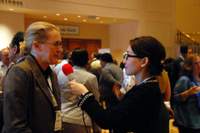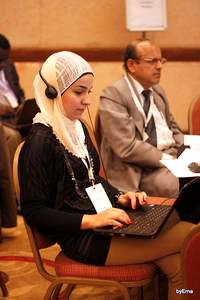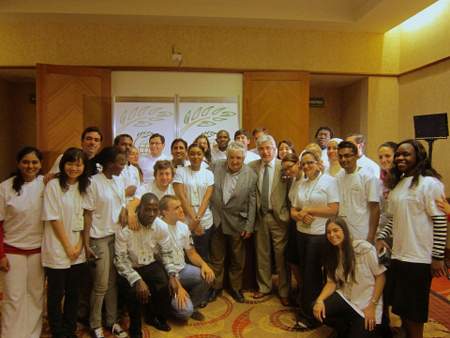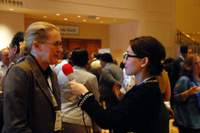The story of a dream, a nightmare and a wish…
The dream
by Enrica Porcari, GCARD2 Communications coordinator
As we planned communication activities for GCARD2, we wanted more than ‘ tell a story’. We wanted to advocate the cause of agriculture, we wanted to include people in the process, before, during, after, and we dreamed of building capacities along the way.
We chose a new way of communicating. Blending traditional and social media and putting young people at the center. Already back in 2010, with colleagues from GFAR, we dreamed about using GCARD as a vehicle to demonstrate the enthusiasm of young researchers and extension agents alike, of students and young graduates, … We dreamed about creating a platform where the youth could have a voice to shape the future they will be living in, where they could demonstrate their work, we wanted to give them “their space on the stage”, and at the same time enrich the GCARD process as a whole.
At GCARD2, we made this dream come true…
The nightmare
by Peter Casier, GCARD2 Social Media coordinator
In 2011, I stood in a field, talking to Kumal, a farmer in Bihar, India. With a sad look in his eyes, he said: “I went to school, but could not find a job, so now, I am just farming my land. I hope for my children to have a better future, to get a job in the city, in construction, or as a cleaner or a desk clerk. Anything, really, except doing as I had to do: farm the land.”
I realized none of the farmers I interviewed in Africa and Asia, actually saw agriculture as a viable future for their children.
This became my nightmare: The biggest challenges “to feed the world” in the near future might not only be solved by helping farmers adapt to shifting weather patterns, not only by breeding drought tolerant maize varieties or flood-prone rice. The biggest challenge for a food-secure world might not only lay in promoting more nutrient-rich crops, drop irrigation and micro-fertilizing… My nightmare was: soon, we might have no farmers left. If farming, agriculture research, extension services are no longer seen as a viable professional future for our kids, then “who will grow the crops that will feed the world”?
“Making agriculture cool again”, could very well be one of the biggest opportunities we have. GCARD2, we found one way to show how cool agriculture really is and engage the youth!
The wish
by Michael Hoevel and Liz Sharma, GCARD2 Traditional Media coordinators
For years now, we have been working with clients in the agricultural sector. As professional media people, we have seen how the mainstream media got interested again in issues like food security, agricultural research, “how to grow more food without wrecking the planet”. For us, that made GCARD2 an ideal platform to approach the press, showcasing the excellent work done on agricultural development and research. And the press was eager to learn more.
But our wish for our media outreach at GCARD2, was from the beginning: how to blend the “traditional media” like newspapers, TV, radio and magazines more with the social media outreach. And to do so, we wished from the start we had good sources for “stories from the ground”. Our group of young agricultural professionals provided those sources..
In GCARD2, one of our wishes came true.
The reality
When we drew the plans for GCARD2’s communication outreach, we combined the dream, the nightmare and the wish into a one-of-a-kind approach: We would blend “traditional” and “social media” for our advocacy campaign – the first pillar of our media strategy.

Engaging a larger group of young people, to report from GCARD2, also allowed us to include more people into the conference and the GCARD process: combining the young and social media we could reach out beyond “those physically present at the conference”. As it turned out, far more people “joined” the conference “virtually” than “physically”. This became our media strategy’s third pillar: “Inclusion“.
From the moment we started our GCARD media project, we seemed to have hit “a winner”: The GFAR Secretariat championed a strong social media and outreach component throughout. The GCARD Organizing Committee supported us by taking the risk of exploring and backing this novel and radical approach. A group of experienced media people from CGIAR agreed to steer the process. And YPARD, the network of Young Professionals working in Agricultural Research for Development, caught fire with just the idea of mobilizing their community of youngsters.
In just a few weeks, we assembled 136 young people, from all over the world, working on the social media outreach. Together, we prepared the technical tools, our detailed strategy, and got familiar with the actual contents of GCARD2. By the time we arrived at GCARD2, the team was ready: We had 35 onsite social reporters (12 international trainees, 7 Uruguayan trainees joined by another 16 young reporters from research centers, NGOs and farmers’ organisations) and 101 offsite support staff. All worked as volunteers with one goal: using social media to report from GCARD2.
The spark
The process and the dynamic within a team of 136 volunteers was something unique to experience. For many of us, even just working, physically and virtually, in a group of 44 nationalities, became something to remember for the rest of our lives.

Just before GCARD2, the young reporters were trained on social media tools for two days: the technical tips and tricks, how to use those to report from a conference and for their own work. Once the conference started, we had the group ready. And boy, did they light the fire!
If we just look objectively at the results of the combined mainstream and social media efforts, it is clear this group did not just do well.. They excelled. Check out these figure (updated to Nov 11):
The proof

The GCARD Blog: The team published 152 blogposts, almost all original content written by our social reporters. From Sept 1 to Nov 11, the blog was visited 16,026 times from 149 countries.
During this period, the blog received 99 comments, showing a very active engagement from the online community.
The GCARD website: From Sept 1 to Nov 11 the GCARD website was visited by 14,719 different people from 181 different countries, who read 104,212 pages.
Twitter: During the conference, we sent out more than 1,500 live Twitter updates PER DAY, reaching an average of 100,000 individual people each day. On the peak day, Oct 29th, we reached 353,623 individual people through Twitter.
Facebook: We posted over 300 updates on Facebook: blogposts, videos, podcasts, press clips and input documents etc.. The Facebook updates were read 20,127 times, and shared 127 times.
Webcast: (online via the EGFAR website) The live webcast was viewed 1,494 times by a total of 1,046 individual people. This effectively doubled the amount of GCARD participants.
During the interactive sessions, questions from the audience watching the webcast, were forwarded to the panels, actively engaging the online audience into the onsite discussions.
YouTube Videos: All webcast sessions were uploaded onto Youtube. We also posted 16 video interviews made by our social reporters. The GCARD videos were viewed 1,471 times to date.
We also promoted the GCARD2010 farmer videos, which were viewed 2,017 times.
Slideshare: 137 input documents and presentations were uploaded to Slideshare. The presentations were viewed 4,551 times. The input documents were viewed 3,561 times.
Flickr Pictures: 820 pictures were uploaded during the conference, another 90 GCARD pictures were uploaded from other accounts. They were viewed 200 times.
Podcasts: 15 podcast interviews were uploaded. These were visited 167 times. Several of these were distributed and broadcasted over the network of rural radios in South America.
Linkedin: A new LinkedIn group was created, on which we posted 84 updates (blogposts and other social media updates). The group now has 41 members.
And there was more: Each day, a digest of previous day’s social media updates was distributed by email to all participants. On Storify, an online daily digest (including the Tweets, blogposts and videos) was published online. A total of 188 GCARD2 articles were published and crossposted on other blogs and online media (check out the list on Storify).
More than “a flash in the pan”

Those statistics and figures are one way to show the results. It is also worth noting that the Uruguayan Minister of Livestock, Agriculture and Fisheries personally gave our young reporters their training certificate, and the Uruguayan president insisted on a press conference, not with the main stream media, but with our social reporting team.
But what is even more rewarding, and more important, is to see how our group of “young reporters” continued with their engagement. Some examples given by our team members:
Meerim Shakirova (Kyrgystan): “CGARD2 helped me to realize my potential in making a global impact, mobilizing youth from all over the world and inspiring global action. We created a Facebook page where we are raising an environmental activism and sustainable living lifestyle through the social media tools.”
Keron Bascombe (Trinidad and Tobago): “GCARD2 made me decide to upgrade my blog about technologies, techniques and methods which can be applied to agriculture. I think, for me, GCARD2 lead the way towards a career in agricultural journalism and communications. I see success in my future and a positive impact upon the agri-sectors.”
Victoria Pereira (Uruguay): “GCARD2 helped me to pay more attention and be more specific about giving my opinion as communicator about agriculture, climate change and all related issues. I now talk more often about these topics in my daily radio program.”
Olawale Ojo (Nigeria): “My experience at the GCARD2 enabled me to use social media tools to spread the word about new initiatives like our “Cool to Farm” workshops via Facebook and Twitter.”
Mai Touma (Syria): “GCARD2 has enabled me to learn more, share, and now perform as a social media reporter: I have now my own blog to write about agricultural development & research at ICARDA, the center where I work. I’m tweeting, Facebooking, knowledge sharing, and setting up a big social media campaign to spread ICARDA worldwide. I do this as a volunteer and show my colleagues these powerful social media can do!”
Noelia de los Santos (Uruguay): “GCARD 2 opened my mind about the power of social media and taught me a lot about how spread the word in different way.”
Caity Peterson (Colombia): “I’m now covering Agriculture Day at COP18 through blogposts, Twitter and Facebook!”
Dinesh Panday (Nepal): “It enhanced my confidence as a messenger and I am continuously sharing to the Nepalese agriculture students in the way of AR4D through YPARD.”
Swathi Sridharan (Zimbabwe): “Participating in GCARD2 remotely from Zimbabwe, I was able to follow instantly what was taking place and, unlike the traditional media stories, really appreciated the informal, chatty, thought provoking opinions of those who were there. It felt more like being part of a large circle of friends at a party, talking and milling around together sharing ideas than the usual way we follow a conference’s ‘outputs’ and ‘outcomes’.”
Nawsheen Hosenally (Mauritius): “I am applying what I have learnt from GCARD2 in my work, focusing on youth in Agriculture and Rural Development. If we want to make a change in Agricultural Research for Development, we cannot ignore the youth and social media!”
Federico Sancho (Costa Rica): “The new role of active communications became clear to me. I am preaching social media everywhere I go.”
Rivaldo Kpadonou (Burkina Faso): “GCARD boosted my interest for blogging for development and non profit causes. Twitter now became my favorite social media channel.”
Msekiwa Matsimbe (Malawi): “GCARD2 made me realize how powerful social media is in making agricultural initiatives visible with zero advertising cost! We started a blog for the NEPAD fish node.”
Myriam Pérez Dumoulin (Spain): “My GCARD2 experience enabled me to have the access to a new job inside my organisation: I’m now starting in the “employability team” where I’ll develop my mission by showing graduates how to use social media in networking and finding job opportunities. I’ll give advice to our students on how to make a “professional-useful-efficient” use of social media. A new horizon for me!”
Codrin Paveliuc-Olariu (Romania): “GCARD2 has shown me new ways in which social media can touch the lives of millions of people around the world involved in the fight against global hunger. I started a new blog on food policy mainly, and am now using Twitter on a daily basis. I also started using additional social networks for my professional goals such as YPLD, research on food security etc.”
Idowu Ejere (Nigeria): “Through GCARD2 I have become more involved with other youth in ARD activities. I am also now spearheading the proposal for a Youth-day at the 6th African Agricultural Science Week next year.”
Marina Cherbonnier (France): “The GCARD2 Social Reporting experience inspired YPARD to carry on soliciting Young Professionals in agriculture to raise their voice through social media, and social reporting of key international events. We are moving on mobilizing “YPs in Agriculture” to integrate COP18 discussions online!”
Alejandra Bentancur (Uruguay): “GCARD2 allowed me to learn how to use social media tools in a coordinated way, with a goal and a defined strategy and how to make a group to organize themselves. In February 2013 we will start a blog for our organisation. The training at GCARD made us use the social media tools even better.”
Machteld Schoolenberg (Netherlands): “At GCARD2 I became very passionate about reporting, and especially through ‘the new media’. Also, GCARD2 confirmed my passion for Agricultural Research for Development (ARD). This realisation was so strong that in the weeks following the conference, I made several appointments to steer my trainee-ship towards a career in ARD and land conservation! yeah! I look forward to keep up the rock and roll with my young social media colleagues for COP18 and more..!”
Engage! Engage! Engage!

As a group, they are now engaging through social media, in two events focusing on food security at COP18, the UNFCCC climate change conference in Doha: The Agriculture, Landscapes and Livelihood Day and the Forest Day.
This continued engagement shows that social reporting from GCARD2, was more than a single event, it was the start of a new beginning, a renewed engagement of our young professionals in agriculture. And that is the most important reward for us, a wish and a dream come true, and a nightmare which might not.
Blogpost by Peter Casier (a.k.a. “Granpa”) – GCARD2 Social Media Coordinator
Pictures by the GCARD2 social media team.



Reblogged this on olawaleojo and commented:
I was part of this, and my life has been changed
Reblogged this on Read Spread Know and commented:
Wonderful blog about the amazing energy and work that came from our Young SocialMedia team! It shows so clearly how to include thousands of people through Social Media! My sincere thanks to Peter Casier, Enrica Porcari, Michael Hoevel, Liz Sharma and of course my young reporter colleagues!
Reblogged this on maitouma.
This is awesome! How can I be a part of this?
Nii,
I am not sure if anyone replied to you, but if you are a young professional working in agriculture, then you can connect with us, via the YPARD email discussion group: https://groups.google.com/forum/#!forum/ypard-smt
Posted this to my Facebook page: http://www.facebook.com/agrifiji
This should serve as encouragement to other Youths in our field..
great initiative. I followed the link posted by Grandpa but was not successful.
Elizabeth